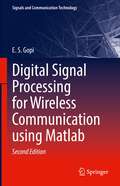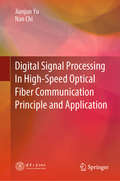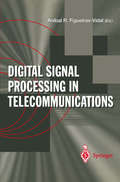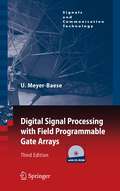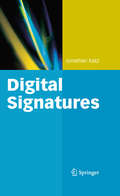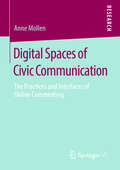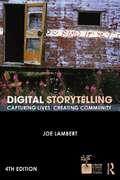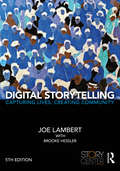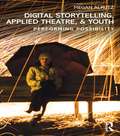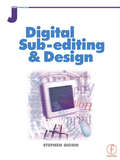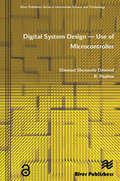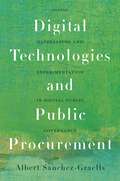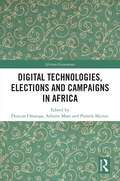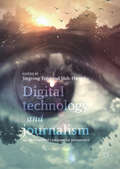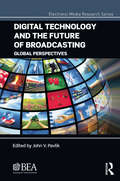- Table View
- List View
Digital Signal Processing for Wireless Communication using Matlab (Signals and Communication Technology)
by E.S. GopiThe updated book presents Matlab illustrations on various digital signal processing (DSP) techniques such as random process, time varying wireless system model, and detection and estimation theory used in wireless communication. The book also covers recent wireless techniques like OFDM, massive MIMO techniques, non-orthogonal multiple access, millimeter wave MIMO, full duplex, cognitive radio, co-operating communication, unmanned aerial vehicles etc. This book is suitable for those who are doing basic and applied research in digital signal processing for wireless communication.
Digital Signal Processing In High-Speed Optical Fiber Communication Principle and Application
by Jianjun Yu Nan ChiThis book presents the principles and applications of optical fiber communication based on digital signal processing (DSP) for both single and multi-carrier modulation signals. In the context of single carrier modulation, it describes DSP for linear and nonlinear optical fiber communication systems, discussing all-optical Nyquist modulation signal generation and processing, and how to use probabilistic and geometrical shaping to improve the transmission performance. For multi-carrier modulation, it examines DSP-based OFDM signal generation and detection and presents 4D and high-order modulation formats. Lastly, it demonstrates how to use artificial intelligence in optical fiber communication. As such it is a useful resource for students, researches and engineers in the field of optical fiber communication.
Digital Signal Processing in Telecommunications: European Project COST#229 Technical Contributions
by Anibal R. Figueiras-VidalThis publication deals with the application of advanced digital signal processing techniques and neural networks to various telecommunication problems. The editor presents the latest research results in areas such as arrays, mobile channels, acoustic echo cancellation, speech coding and adaptive filtering in varying environments.
Digital Signal Processing with Field Programmable Gate Arrays (Signals and Communication Technology)
by Uwe Meyer-BaeseA practical and fascinating book on a topic at the forefront of communications technology. Field-Programmable Gate Arrays (FPGAs) are on the verge of revolutionizing digital signal processing. Novel FPGA families are replacing ASICs and PDSPs for front-end digital signal processing algorithms at an accelerating rate. The efficient implementation of these algorithms is the main goal of this book. It starts with an overview of today's FPGA technology, devices, and tools for designing state-of-the-art DSP systems. Each of the book’s chapter contains exercises. The VERILOG source code and a glossary are given in the appendices.
Digital Signatures
by Jonathan KatzAs a beginning graduate student, I recall being frustrated by a general lack of acces sible sources from which I could learn about (theoretical) cryptography. I remember wondering: why aren’t there more books presenting the basics of cryptography at an introductory level? Jumping ahead almost a decade later, as a faculty member my graduate students now ask me: what is the best resource for learning about (various topics in) cryptography? This monograph is intended to serve as an answer to these 1 questions — at least with regard to digital signature schemes. Given the above motivation, this book has been written with a beginninggraduate student in mind: a student who is potentially interested in doing research in the ?eld of cryptography, and who has taken an introductory course on the subject, but is not sure where to turn next. Though intended primarily for that audience, I hope that advanced graduate students and researchers will ?nd the book useful as well. In addition to covering various constructions of digital signature schemes in a uni?ed framework, this text also serves as a compendium of various “folklore” results that are, perhaps, not as well known as they should be. This book could also serve as a textbook for a graduate seminar on advanced cryptography; in such a class, I expect the entire book could be covered at a leisurely pace in one semester with perhaps some time left over for excursions into related topics.
Digital Spaces of Civic Communication: The Practices and Interfaces of Online Commenting
by Anne MollenThis book addresses the socio-technical constitution of civic communication in increasingly digital democracies. Despite problematic phenomena like hate speech in online commenting, it argues that citizens’ potential for resisting technological inscriptions in digital media remains a fundamental democratic right. While producers inscribe anticipations for how people should be discussing political issues into commenting interfaces, citizens still resist these technological inscriptions in their commenting practices. This dialectic interrelation between interfaces and practices highlights the inadequacy of purely technological solutions for undemocratic tendencies in digital media.
Digital Storytelling: Capturing Lives, Creating Community
by Joe LambertListen deeply. Tell stories. This is the mantra of the Center for Digital Storytelling (CDS) in Berkeley California, which, since 1998 has worked with nearly 1,000 organizations around the world and trained more than 15,000 people in the art of digital storytelling. In this revised and updated edition of the CDS's popular guide to digital storytelling, co-founder Joe Lambert details the history and methods of digital storytelling practices. Using a "7 Steps" approach, Lambert helps storytellers identify the fundamentals of dynamic digital storytelling--from seeing the story, assembling it, and sharing it. As in the last edition, readers of the fourth edition will also find new explorations of the applications of digital storytelling and updated appendices that provide resources for budding digital storytellers, including information about past and present CDS-affiliated projects and place-based storytelling, a narrative-based approach to understanding experience and landscape. A companion website further brings the entire storytelling process to life. Over the years, the CDS's work has transformed the way that community activists, educators, health and human services agencies, business professionals, and artists think about story, media, culture, and the power of personal voice in creating change. For those who yearn to tell multimedia stories, Digital Storytelling is the place to begin.
Digital Storytelling: Capturing Lives, Creating Community
by Joe LambertListen deeply. Tell stories. This is the mantra of the Center for Digital Storytelling (CDS) in Berkeley California, which, since 1998 has worked with nearly 1,000 organizations around the world and trained more than 15,000 people in the art of digital storytelling. In this revised and updated edition of the CDS's popular guide to digital storytelling, co-founder Joe Lambert details the history and methods of digital storytelling practices. Using a "7 Steps" approach, Lambert helps storytellers identify the fundamentals of dynamic digital storytelling--from seeing the story, assembling it, and sharing it. As in the last edition, readers of the fourth edition will also find new explorations of the applications of digital storytelling and updated appendices that provide resources for budding digital storytellers, including information about past and present CDS-affiliated projects and place-based storytelling, a narrative-based approach to understanding experience and landscape. A companion website further brings the entire storytelling process to life. Over the years, the CDS's work has transformed the way that community activists, educators, health and human services agencies, business professionals, and artists think about story, media, culture, and the power of personal voice in creating change. For those who yearn to tell multimedia stories, Digital Storytelling is the place to begin.
Digital Storytelling: Capturing Lives, Creating Community
by Joe Lambert Brooke HesslerIn this revised and updated edition of the StoryCenter's popular guide to digital storytelling, StoryCenter founder Joe Lambert offers budding storytellers the skills and tools they need to craft compelling digital stories. Using a "Seven Steps" approach, Lambert helps storytellers identify the fundamentals of dynamic digital storytelling – from conceiving a story, to seeing, assembling, and sharing it. Readers will also find new explorations of the global applications of digital storytelling in education and other fields, as well as additional information about copyright, ethics, and distribution. The book is filled with resources about past and present projects on the grassroots and institutional level, including new chapters specifically for students and a discussion of the latest tools and projects in mobile device-based media. This accessible guide’s meaningful examples and inviting tone makes this an essential for any student learning the steps toward digital storytelling.
Digital Storytelling: Capturing Lives, Creating Community
by Joe Lambert Brooke HesslerIn this revised and updated edition of the StoryCenter's popular guide to digital storytelling, StoryCenter founder Joe Lambert offers budding storytellers the skills and tools they need to craft compelling digital stories. Using a "Seven Steps" approach, Lambert helps storytellers identify the fundamentals of dynamic digital storytelling – from conceiving a story, to seeing, assembling, and sharing it. Readers will also find new explorations of the global applications of digital storytelling in education and other fields, as well as additional information about copyright, ethics, and distribution. The book is filled with resources about past and present projects on the grassroots and institutional level, including new chapters specifically for students and a discussion of the latest tools and projects in mobile device-based media. This accessible guide’s meaningful examples and inviting tone makes this an essential for any student learning the steps toward digital storytelling.
Digital Storytelling, Applied Theatre, & Youth: Performing Possibility
by Megan AlrutzDigital Storytelling, Applied Theatre, & Youth argues that theatre artists must re-imagine how and why they facilitate performance practices with young people. Rapid globalization and advances in media and technology continue to change the ways that people engage with and understand the world around them. Drawing on pedagogical, aesthetic, and theoretical threads of applied theatre and media practices, this book presents practitioners, scholars, and educators with innovative approaches to devising and performing digital stories. This book offers the first comprehensive examination of digital storytelling as an applied theatre practice. Alrutz explores how participatory and mediated performance practices can engage the wisdom and experience of youth; build knowledge about self, others and society; and invite dialogue and deliberation with audiences. In doing so, she theorizes digital storytelling as a site of possibility for critical and relational practices, feminist performance pedagogies, and alliance building with young people.
Digital Storytelling, Applied Theatre, & Youth: Performing Possibility
by Megan AlrutzDigital Storytelling, Applied Theatre, & Youth argues that theatre artists must re-imagine how and why they facilitate performance practices with young people. Rapid globalization and advances in media and technology continue to change the ways that people engage with and understand the world around them. Drawing on pedagogical, aesthetic, and theoretical threads of applied theatre and media practices, this book presents practitioners, scholars, and educators with innovative approaches to devising and performing digital stories. This book offers the first comprehensive examination of digital storytelling as an applied theatre practice. Alrutz explores how participatory and mediated performance practices can engage the wisdom and experience of youth; build knowledge about self, others and society; and invite dialogue and deliberation with audiences. In doing so, she theorizes digital storytelling as a site of possibility for critical and relational practices, feminist performance pedagogies, and alliance building with young people.
Digital Sub-Editing and Design
by Stephen QuinnThis excellent book covers editing in the digital age, demonstrating the tools needed for effective text editing. Learn how to write powerful headlines and captions, and how to edit body text quickly and cleanly. It also concentrates on design in the digital environment, introducing typography and the related issues of readability and legibility. The skills of picture editing are explored, including image selection, cropping, manipulation and the ethics involved. These core skills and methods are then applied to the World Wide Web. Recent research into how people navigate Web pages is considered, and recommends ways to write more effectively for the online medium. The first section concentrates on editing in the digital age, demonstrating the tools needed for effective text editing. Dr Quinn shows how to write powerful headlines and captions, and how to edit body text quickly and cleanly. The middle section concentrates on design in the digital environment. Chapter five introduces typography and the related issues of readability and legibility. Chapter six covers the principles of design and how they can be applied to print and electronic publications. Chapter seven looks at the skills of picture editing, including image selection, cropping, manipulation and the ethics involved. Chapter eight investigates other forms of visual presentation such as diagrams, logos, maps and cartoons. In the final section, these core skills and methods are applied to the World Wide Web. Chapter nine considers recent research into how people navigate Web pages, and recommends ways to write more effectively for the online medium. Chapter ten examines how the principles of print design can (and cannot) be applied to Web pages.
Digital Sub-Editing and Design
by Stephen QuinnThis excellent book covers editing in the digital age, demonstrating the tools needed for effective text editing. Learn how to write powerful headlines and captions, and how to edit body text quickly and cleanly. It also concentrates on design in the digital environment, introducing typography and the related issues of readability and legibility. The skills of picture editing are explored, including image selection, cropping, manipulation and the ethics involved. These core skills and methods are then applied to the World Wide Web. Recent research into how people navigate Web pages is considered, and recommends ways to write more effectively for the online medium. The first section concentrates on editing in the digital age, demonstrating the tools needed for effective text editing. Dr Quinn shows how to write powerful headlines and captions, and how to edit body text quickly and cleanly. The middle section concentrates on design in the digital environment. Chapter five introduces typography and the related issues of readability and legibility. Chapter six covers the principles of design and how they can be applied to print and electronic publications. Chapter seven looks at the skills of picture editing, including image selection, cropping, manipulation and the ethics involved. Chapter eight investigates other forms of visual presentation such as diagrams, logos, maps and cartoons. In the final section, these core skills and methods are applied to the World Wide Web. Chapter nine considers recent research into how people navigate Web pages, and recommends ways to write more effectively for the online medium. Chapter ten examines how the principles of print design can (and cannot) be applied to Web pages.
Digital Synthesizers and Transmitters for Software Radio
by Jouko VankkaThe approach adopted in Digital Synthesizers and Transmitters for Software Radio will provide an understanding of key areas in the field of digital synthesizers and transmitters. It is easy to include different digital techniques in the digital synthesizers and transmitters by using digital signal processing methods, because the signal is in digital form. By programming the digital synthesizers and transmitters, adaptive channel bandwidths, modulation formats, frequency hopping and data rates are easily achieved. Techniques such as digital predistortion for power amplifier linearization, digital compensation methods for analog I/Q modulator nonlinearities and digital power control and ramping are presented in this book. The flexibility of the digital synthesizers and transmitters makes them ideal as signal generators for software radio. Software radios represent a major change in the design paradigm for radios in which a large portion of the functionality is implemented through programmable signal processing devices, giving the radio the ability to change its operating parameters to accommodate new features and capabilities. A software radio approach reduces the content of radio frequency (RF) and other analog components of traditional radios and emphasizes digital signal processing to enhance overall transmitter flexibility. Software radios are emerging in commercial and military infrastructure.
Digital System Design - Use of Microcontroller
by Shenouda Dawoud R. PeplowEmbedded systems are today, widely deployed in just about every piece of machinery from toasters to spacecraft. Embedded system designers face many challenges. They are asked to produce increasingly complex systems using the latest technologies, but these technologies are changing faster than ever. They are asked to produce better quality designs with a shorter time-to-market. They are asked to implement increasingly complex functionality but more importantly to satisfy numerous other constraints. To achieve the current goals of design, the designer must be aware with such design constraints and more importantly, the factors that have a direct effect on them.One of the challenges facing embedded system designers is the selection of the optimum processor for the application in hand; single-purpose, general-purpose or application specific. Microcontrollers are one member of the family of the application specific processors.The book concentrates on the use of microcontroller as the embedded system?s processor, and how to use it in many embedded system applications. The book covers both the hardware and software aspects needed to design using microcontroller.The book is ideal for undergraduate students and also the engineers that are working in the field of digital system design.Contents• Preface;• Process design metrics;• A systems approach to digital system design;• Introduction to microcontrollers and microprocessors;• Instructions and Instruction sets;• Machine language and assembly language;• System memory; Timers, counters and watchdog timer;• Interfacing to local devices / peripherals;• Analogue data and the analogue I/O subsystem;• Multiprocessor communications;• Serial Communications and Network-based interfaces.
Digital System Design - Use of Microcontroller
by Shenouda Dawoud R. PeplowEmbedded systems are today, widely deployed in just about every piece of machinery from toasters to spacecraft. Embedded system designers face many challenges. They are asked to produce increasingly complex systems using the latest technologies, but these technologies are changing faster than ever. They are asked to produce better quality designs with a shorter time-to-market. They are asked to implement increasingly complex functionality but more importantly to satisfy numerous other constraints. To achieve the current goals of design, the designer must be aware with such design constraints and more importantly, the factors that have a direct effect on them.One of the challenges facing embedded system designers is the selection of the optimum processor for the application in hand; single-purpose, general-purpose or application specific. Microcontrollers are one member of the family of the application specific processors.The book concentrates on the use of microcontroller as the embedded system?s processor, and how to use it in many embedded system applications. The book covers both the hardware and software aspects needed to design using microcontroller.The book is ideal for undergraduate students and also the engineers that are working in the field of digital system design.Contents• Preface;• Process design metrics;• A systems approach to digital system design;• Introduction to microcontrollers and microprocessors;• Instructions and Instruction sets;• Machine language and assembly language;• System memory; Timers, counters and watchdog timer;• Interfacing to local devices / peripherals;• Analogue data and the analogue I/O subsystem;• Multiprocessor communications;• Serial Communications and Network-based interfaces.
Digital Technologies and Public Procurement: Gatekeeping and Experimentation in Digital Public Governance
by Albert Sanchez-GraellsThe digital transformation of the public sector has accelerated. States are experimenting with technology, seeking more streamlined and efficient digital government and public services. However, there are significant concerns about the risks and harms to individual and collective rights under new modes of digital public governance. Several jurisdictions are attempting to regulate digital technologies, especially artificial intelligence, however regulatory effort primarily concentrates on technology use by companies, not by governments. The regulatory gap underpinning public sector digitalisation is growing. As it controls the acquisition of digital technologies, public procurement has emerged as a 'regulatory fix' to govern public sector digitalisation. It seeks to ensure through its contracts that public sector digitalisation is trustworthy, ethical, responsible, transparent, fair, and (cyber) safe. However, in Digital Technologies and Public Procurement: Gatekeeping and Experimentation in Digital Public Governance, Albert Sanchez-Graells argues that procurement cannot perform this gatekeeping role effectively. Through a detailed case study of procurement digitalisation as a site of unregulated technological experimentation, he demonstrates that relying on 'regulation by contract' creates a false sense of security in governing the transition towards digital public governance. This leaves the public sector exposed to the 'policy irresistibility' that surrounds hyped digital technologies. Bringing together insights from political economy, public policy, science, technology, and legal scholarship, this thought-provoking book proposes an alternative regulatory approach and contributes to broader debates of digital constitutionalism and digital technology regulation.
Digital Technologies and Public Procurement: Gatekeeping and Experimentation in Digital Public Governance
by Albert Sanchez-GraellsThe digital transformation of the public sector has accelerated. States are experimenting with technology, seeking more streamlined and efficient digital government and public services. However, there are significant concerns about the risks and harms to individual and collective rights under new modes of digital public governance. Several jurisdictions are attempting to regulate digital technologies, especially artificial intelligence, however regulatory effort primarily concentrates on technology use by companies, not by governments. The regulatory gap underpinning public sector digitalisation is growing. As it controls the acquisition of digital technologies, public procurement has emerged as a 'regulatory fix' to govern public sector digitalisation. It seeks to ensure through its contracts that public sector digitalisation is trustworthy, ethical, responsible, transparent, fair, and (cyber) safe. However, in Digital Technologies and Public Procurement: Gatekeeping and Experimentation in Digital Public Governance, Albert Sanchez-Graells argues that procurement cannot perform this gatekeeping role effectively. Through a detailed case study of procurement digitalisation as a site of unregulated technological experimentation, he demonstrates that relying on 'regulation by contract' creates a false sense of security in governing the transition towards digital public governance. This leaves the public sector exposed to the 'policy irresistibility' that surrounds hyped digital technologies. Bringing together insights from political economy, public policy, science, technology, and legal scholarship, this thought-provoking book proposes an alternative regulatory approach and contributes to broader debates of digital constitutionalism and digital technology regulation.
Digital Technologies, Elections and Campaigns in Africa (African Governance)
by Duncan Omanga Admire Mare Pamela MainyeThis book looks at how digital technologies are revolutionizing electoral campaigns and democratization struggles in Africa. Digital technologies are giving voice and civic agency to a cross section of African voters, providing important spaces for political engagement and debate. Drawing on cases from Kenya, Uganda, Mozambique, Nigeria, Ethiopia, and Zimbabwe amongst others, this book traces the shifts and tensions in this changing electoral communications landscape. In doing so, the book explores themes such as hate speech and disinformation, decolonisation, surveillance, internet shutdowns, influencers, bots, algorithms, and election observation, and looks beyond Facebook, Twitter, WhatsApp and YouTube to the increasingly important role of visual platforms such as Instagram and TikTok. Particularly highlighting the contribution of African scholars, this book is an important guide for researchers across the fields of African politics, media studies, and electoral studies, as well as to professionals and policymakers in political communication.
Digital Technologies, Elections and Campaigns in Africa (African Governance)
This book looks at how digital technologies are revolutionizing electoral campaigns and democratization struggles in Africa. Digital technologies are giving voice and civic agency to a cross section of African voters, providing important spaces for political engagement and debate. Drawing on cases from Kenya, Uganda, Mozambique, Nigeria, Ethiopia, and Zimbabwe amongst others, this book traces the shifts and tensions in this changing electoral communications landscape. In doing so, the book explores themes such as hate speech and disinformation, decolonisation, surveillance, internet shutdowns, influencers, bots, algorithms, and election observation, and looks beyond Facebook, Twitter, WhatsApp and YouTube to the increasingly important role of visual platforms such as Instagram and TikTok. Particularly highlighting the contribution of African scholars, this book is an important guide for researchers across the fields of African politics, media studies, and electoral studies, as well as to professionals and policymakers in political communication.
Digital Technology and Journalism: An International Comparative Perspective
by Jingrong Tong Shih-Hung LoThis edited volume discusses the theoretical, practical and methodological issues surrounding changes in journalism in the digital era. The chapters explore how technological innovations have transformed journalism and how an international comparative perspective can contribute to our understanding of the topic. Journalism is examined within Anglo-American and European contexts as well as in Asia and Africa, and comparative approaches and methods for journalism studies in the digital age are evaluated. In so doing, the book offers a thorough investigation of changes in journalistic norms, practices and genres in addition to providing an international and comparative perspective for understanding these changes and what they mean to journalism. Written by both leading scholars and media practitioners in the field, the articles in this collection are based on theoretical frameworks and empirical data, drawn from content analysis of newspaper and online coverage, in-depth interviews with news practitioners, observation on the websites of news organisations and analysis of journalists on Twitter. The result is a cohesive compilation that offers the reader an up-to-date and comprehensive understanding of digital developments in journalism and comparative journalism studies.
Digital Technology and Journalism: An International Comparative Perspective
by Jingrong Tong Shih-Hung LoThis edited volume discusses the theoretical, practical and methodological issues surrounding changes in journalism in the digital era. The chapters explore how technological innovations have transformed journalism and how an international comparative perspective can contribute to our understanding of the topic. Journalism is examined within Anglo-American and European contexts as well as in Asia and Africa, and comparative approaches and methods for journalism studies in the digital age are evaluated. In so doing, the book offers a thorough investigation of changes in journalistic norms, practices and genres in addition to providing an international and comparative perspective for understanding these changes and what they mean to journalism. Written by both leading scholars and media practitioners in the field, the articles in this collection are based on theoretical frameworks and empirical data, drawn from content analysis of newspaper and online coverage, in-depth interviews with news practitioners, observation on the websites of news organisations and analysis of journalists on Twitter. The result is a cohesive compilation that offers the reader an up-to-date and comprehensive understanding of digital developments in journalism and comparative journalism studies.
Digital Technology and the Future of Broadcasting: Global Perspectives (Electronic Media Research Series)
by John V. PavlikThis volume presents timely discussions on how digital technology is reshaping broadcasting and the media in the United States and around the world. It features contributions from distinguished scholars and young researchers, representing work that spans domestic and international issues of technological change and the implications for broadcasting and related media in a global context. Among the many issues covered are: The impact of digital technology on the structure of broadcasting organizations and regulation; The nature of broadcast content or media programming and how it is delivered at home and abroad; Engagement and interaction of the public with broadcasting and social and mobile media; and The reshaping of revenue models for broadcasters and media organizations globally. The first two parts of the volume, addressing research challenges, issues, and advances in global broadcasting, are competitively reviewed research papers which were presented at the BEA2014 Research Symposium. The third part focuses on international perspectives, with chapters from broadcasting scholars and paper discussants at the Research Symposium. This section provides reflection on the problems and prospects for research, education, and public policy that arise in this era of rapid and continuing change. As a benchmark of the remarkable changes taking place in today’s media environment, the volume sets an agenda for future research on the implications of digital technology for broadcasting and broadcasting education.
Digital Technology and the Future of Broadcasting: Global Perspectives (Electronic Media Research Series)
by John V. PavlikThis volume presents timely discussions on how digital technology is reshaping broadcasting and the media in the United States and around the world. It features contributions from distinguished scholars and young researchers, representing work that spans domestic and international issues of technological change and the implications for broadcasting and related media in a global context. Among the many issues covered are: The impact of digital technology on the structure of broadcasting organizations and regulation; The nature of broadcast content or media programming and how it is delivered at home and abroad; Engagement and interaction of the public with broadcasting and social and mobile media; and The reshaping of revenue models for broadcasters and media organizations globally. The first two parts of the volume, addressing research challenges, issues, and advances in global broadcasting, are competitively reviewed research papers which were presented at the BEA2014 Research Symposium. The third part focuses on international perspectives, with chapters from broadcasting scholars and paper discussants at the Research Symposium. This section provides reflection on the problems and prospects for research, education, and public policy that arise in this era of rapid and continuing change. As a benchmark of the remarkable changes taking place in today’s media environment, the volume sets an agenda for future research on the implications of digital technology for broadcasting and broadcasting education.
